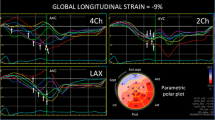Summary
Resynchronization of segmental left ventricular mechanics as well as re-cordination of both atrio-ventricular and inter-ventricular contraction are potential mechanisms responsible for the clinical benefit observed in patients with advanced congestive heart failure treated by cardiac resynchronization therapy (CRT). Initially electrical conduction problems, in the majority of cases a left bundle branch block (LBBB), were considered the target for CRT. However, growing experience with CRT in different patient populations including those with milder degrees of conduction disturbance, and improved cardiac imaging utilizing the tissue Doppler approach, have shown the complexity of CRT and the usefulness of sophisticated echocardiographic imaging techniques for therapeutic decision making and optimization of CRT device settings.
Similar content being viewed by others
References
Abraham WT, Fisher WG, Smith AL, Delurgio DB, Leon AR, Loh E, Kocovic DZ, Packer M, Clavell AL, Hayes DL, Ellestad M, Messenger J for the MIRACLE Study Group (2002) Cardiac resynchronization in chronic heart failure. New Engl J Med 346:1845–1853
Aranda JM, Carlson ER, Pauly DF, Curtis AB, Conti RC, Ariet M, Hill JA, MD (2002) QRS duration variability in patients with heart failure. Am J Cardiol 9:335–337
Auricchio A, Salo R (1997) Acute hemodynamic improvement by pacing in patients with severe congestive heart failure. Pacing Clin Electrophysiol 20:313–324
Auricchio A, Ding J, Spinelli JC, Kramer AP, Salo RW, Hoersch W, Knight BH, Klein HU for PATH-CHF Study Group (2002) Cardiac resynchronization therapy restores optimal atrioventricular mechanical timing in heart failure patients with ventricular conduction delay. J Am Coll Cardiol 39:1163–1169
Auricchio A, Stellbrink C, Block M, Sack S, Vogt J, Bakker P, Klein H for the Pacing Therapies for Congestive Heart Failure Study Group; Kramer A, Ding J, Salo R, Tockman B, Pochet T, Spinelli J, for the Guidant Congestive Heart Failure Research Group (1999) Effect of pacing chamber and atrioventricular delay on acute systolic function of paced patients with congestive heart failure. Circulation 99:2993–3001
Bax JJ, Molhoek SG, Marwick TH, van Erven L, Voogd PJ, Somer S, Boersma E, Steendijk P, Schalij MJ, Van der Wall EE (2003) Usefulness of myocardial tissue Doppler echocardiography to evaluate left ventricular dyssynchrony before and after biventricular pacing in patients with idiopathic dilated cardiomyopathy. Am J Cardiol 91:94–97
Braunschweig F, Linde C, Gadler F, Rydén L (2000) Reduction of Hospital Days by Biventricular Pacing. Eur. J. Heart Failure 2:399–406
Breithardt OA, Stellbrink C, Kramer AP, Sinha AM, Franke A, Salo R, Schiffgens B, Huvelle E, Auricchio A, for the PATH-CHF Study Group (2002) Echocardiographic Quantification of Left Ventricular Asynchrony Predicts an Acute Hemodynamic Benefit of Cardiac Resynchronization Therapy. J Am Coll Cardiol 40:536–545
Breithardt OA, Kühl HP, Stellbrink C (2002) Acute effects of resynchronisation treatment on functional mitral regurgitation in dilated cardiomyopathy. Heart 88:440–445
Breithardt OA, Stellbrink C, Herbots L, Claus P, Sinha AM, Bijnens B, Hanrath P, Sutherland GR (2003) Cardiac resynchronization therapy can reverse abnormal myocardial strain distribution in paients with heart failure and left bundle branch block. J Am Coll Cardiol 42:486–494
Cazeau S, Leclercq C, Lavergne T et al, for the Multisite Stimulation In Cardiomyopathies (MUSTIC) Study Investigators (2001) Effects of Multisite Biventricular Pacing in Patients With Heart Failure and Intraventricular Conduction Delay. New Engl J Med 344:873–880
Cleland JGF, Daubert JC, Erdmann E et al (2005) The effect of cardiac resynchronization therapy on morbidity and mortality in chronic heart failure. New Engl J Med 352:1539–1549
Faber L, Lamp B, Vogt J, Heintze J, Hansky B, Körfer R, Horstkotte D (2004) Tissue Doppler imaging in patients with congestive heart failure and conduction disorders. Eur Heart J 6(Supp D):D10–16
Faber L, Lamp B, Hering D, Bogunovic N, Scholtz W, Heintze J, Vogt J, Horstkotte D (2003) Analyse der inter- und intraventrikulären Asynchronie mittels Flu- und Gewebe-Dopplerechokardiographie: Was bedeutet kardiale Asynchronie? Z Kardiol 92:994–1002
Oguz E, Dagdeviren B, Bilsel T, Akdemir O, Erdinler I, Akyol A, Ulufer T, Tezel T, Gurkan K (2002) Echocardiographic prediction of long-term response to biventricular pacemaker in severe heart failure. Eur J Heart Failure 4:83–90
Garrigue S, Reuter S, Labeque JN, Jais P, Hocini M, Shah DC, Haissaguerre M, Clementy J (2001) Usefulness of Biventricular Pacing in Patients With Congestive Heart Failure and Right Bundle Branch Block. Am J Cardiol 88:1436–1441
Garrigue S, Bordachar P, Reuter S, Jas P, Kobeissi A, Gaggini G, Hassa-M, Clementy J (2002) Comparison of permanent left ventricular and biventricular pacing in patients with heart failure and chronic atrial fibrillation: prospective haemodynamic study. Heart 87:529–534
Igarashi M, Shiina Y, Tanabe T, Handa S (2002) Significance of electrocardiographic QRS width in patients with congestive heart failure: a marker for biventricular pacing. J Cardiol 40:103–109
Leclercq C, Faris O, Tunin R, Johnson J, Kato R, Evans F, Spinelli J, Halperin H, McVeigh E, Kass DA (2002) Systolic improvement and mechanical resynchronization does not require electrical synchrony in the dilated failing heart with left bundle-branch block. Circulation 106:1760–1763
Lecoq G, Leclercq C, Leray E, Crocq C, Alonso C, de Place C, Mabo P, Daubert C (2005) Clinical and electrocardiographic predictors of a positive response to cardiac resynchronization therapy in advanced heart failure. Eur Heart J 26:1094–1100
Lemke B, Nowak D, Pfeiffer D (2005) Leitlinien zur Herzschrittmachertherapie. www.dgk.org/leitlinien/
Le Rest C, Couturier O, Turzo A et al (1999) Use of left ventricular pacing in heart failure: evaluation by gated blood pool imaging. J Nucl Cardiol 6:651–656
Linde C, Leclercq C, Rex S, Garrigue S, Lavergne T, Cazeau S, McKenna W, Fitzgerald M, Deharo J-C, MD, Alonso C, Walker S, MD, Braunschweig F, Bailleul C, Daubert J-C, on behalf of the MUltisite STimulation In Cardiomyopathies (MUSTIC) Study Group (2002) Long-term benefits of biventricular pacing in congestive heart failure: results from the Multisite Stimulation In Cardiomyopathy (MUSTIC) Study. J Am Coll Cardiol 40:111–118
Lupi G, Brignole M, Oddone D et al (2000) Effects of Left Ventricular Pacing on Cardiac Performance and on Quality of Life in Patients With Drug Refractory Heart Failure. Am J Cardiol 86:1267–1270
Mansourati J, Etienne Y, Gilard M, Valls-Bertault V, Boschat J, Benditt D, Lurie K, Blanc JJ (2000) Left ventricular-based pacing in patients with chronic heart failure: comparison of acute hemodynamic benefits according to underlying heart disease. Eur. J. Heart Failure 2:195–199
Makaryus AN, Arduini AD, Mallin J, Chung E, Kort S, Shi Q, Jadonath R, Mangion J (2003) Echocardiographic features of patients with heart failure who may benefit from biventricular pacing. Echocardiography 20:217–223
Nelson GS, Berger RD, Fetics BJ et al (2000) Left Ventricular or Biventricular Pacing Improves Cardiac Function at Diminished Energy Cost in Patients With Dilated Cardiomyopathy and Left Bundle-Branch Block. Circulation 102:3053–3059
Penicka M, Bartunek J, De Bruyne B, Vanderheyden M, Goethals M, De Zutter M, Brugada P, Geelen P (2004) Improvement of left ventricular function after cardiac resynchronization therapy is predicted by tissue Doppler imaging echocardiography. Circulation 109:978–983
Pitzalis MV, Iacoviello M, Romito R, Guida P, De Tommasi E, Luzzi G, Anaclerio M, Forleo C, Rizzon P (2005) Ventricular asynchrony predicts a better outcome in patients with chronic heart failure receiving cardiac resynchronization therapy. J Am Coll Cardiol 45:65–69
Reuter S, Garrigue S, Barold SS, Jais P, Hocini M, Haissaguerre M, Clementy (2002) Comparison of Characteristics in Responders Versus Nonresponders With Biventricular Pacing for Drug-Resistant Congestive Heart Failure. Am J Cardiol 89:346–350
Schuster P, Faerestrand S, Ohm OJ (2003) Colour tissue velocity imaging can show resynchronisation of longitudinal LV contraction patterns by biventricular pacing in patients with severe heart failure. Heart 89:859–864
Søgaard P, Egeblad H, Kim WY, Jensen HK, Pedersen AK, Kristensen Bø, Mortensen PT (2002) Tissue Doppler Imaging Predicts Improved Systolic Performance and Reversed Left Ventricular Remodeling During Long-Term Cardiac Resynchronization Therapy. J Am Coll Cardiol 40:723–730
Søgaard P, Egeblad H, Pedersen AK, Kim WY, Kristensen Bø, Hansen PS, Mortensen PT (2002) Sequential Versus Simultaneous Biventricular Resynchronization for Severe Heart Failure Evaluation by Tissue Doppler Imaging. Circulation 106:2078–2084
Swedberg C (chairperson) et al (2005) Guidelines for the diagnosis and treatment of chronic heart failure. Eur Heart J (doi: 10 1093 (eurheartj/ehj 205)
Touiza A, Etienne Y, Gilard M, Fatemi M, Mansourati J, Blanc J (2001) Long-Term Left Ventricular Pacing: Assessment and Comparison With Biventricular Pacing in Patients With Severe Congestive Heart Failure. J Am Coll Cardiol 38:1966–1970
Varma C, O’Callaghan P, Mahon NG, Hnatkova K, McKenna W, Camm AJ, Rowland E, Brecker SJD (2002) Effect of Multisite Pacing on Ventricular Coordination. Heart 87:322–328
Vogt J, Lamp B, Heintze J, Hansky B, Krater L, Warzok F, Gueldner H, Koerfer R, Horstkotte D (2001) Preimplant testing is the key to optimize resynchronization therapy. Circulation 104(Suppl 2):406–417
Yu CM, Lin H, Zhang Q, Sanderson JE (2003) High prevalence of left ventricular systolic and diastolic asynchrony in patients with congestive heart failure and normal QRS duration. Heart 89:54–60
Yu CM, Chau E, Sanderson JE, Fan K, Tang MO, Fung WH, Lin H, Kong SL, Lam YM, Hill MRS, Lau CP (2002) Tissue Doppler Echocardiographic Evidence of Reverse Remodeling and Improved Synchronicity by Simultaneously Delaying Regional Contraction After Biventricular Pacing Therapy in Heart Failure. Circulation 105:438–445
Yu CM, Fung JW, Zhang Q, Chan CK, Chan YS, Lin H, Kum LC, Kong SL, Zhang Y, Sanderson JE (2004) Tissue Doppler imaging is superior to strain rate imaging and postsystolic shortening on the prediction of reverse remodeling in both ischemic and nonischemic heart failure after cardiac resynchronization therapy. Circulation 110:66–73
Zamorano J (1999) Is tissue Doppler echocardiography ready for clinical application? Eur Heart J 20:558–560
Author information
Authors and Affiliations
Corresponding author
Rights and permissions
About this article
Cite this article
Faber, L. Echocardiography-based optimization of cardiac resynchronization therapy in patients with congestive heart failure and conduction disorders. Herzschr. Elektrophys. 17 (Suppl 1), i73–i79 (2006). https://doi.org/10.1007/s00399-006-1111-y
Issue Date:
DOI: https://doi.org/10.1007/s00399-006-1111-y




